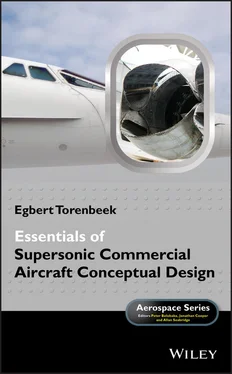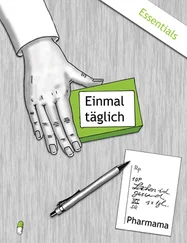The development of supersonic technology since the end of the twentieth century has primarily advanced in the field of transonic and supersonic aerodynamics. For example, many studies have been carried out in the field of configurations with oblique wings, promising improvements in flight efficiency of up to 20% as well as large gains in reducing the sonic boom, take‐off noise, and low‐speed performance improvements. From this point of view, a new generation of supersonic passenger aircraft could have a commercial future a decade from now.
Although the present generation of aircraft designers has enjoyed an introduction to the physics of supersonic flows during their academic education, not many of them have actually experienced activities associated with the design of a supersonic cruise vehicle. Fortunately, a wealth of high‐quality information on applied supersonic aerodynamics is available in classical books such as the well known books of D. Küchemann, J.D. Anderson and D.L. Raymer. Together these texts provide a comprehensive introduction into the fundamentals, and analytical and computational treatment of high‐speed flows.
The author is indebted to Professor Leo Veldhuis for his hospitality by offering me a room to continue writing this book during many years after my retirement. Moreover, many colleagues have assisted me in solving problems in the application of the LATEX program, in particular Dr. Roelof Vos, Dr. Maurice Hoogreef and Ir. Reno Elmendorp.
1 History of Supersonic Transport Aircraft Development
At the end of the 1950s military jet aircraft made routine flights at speeds faster than sound, and the first generation of long‐range high‐subsonic jet‐powered airliners had only just been introduced into service, when it was realized that supersonic airliners could become a reality. The commercial potential for supersonic flight came under serious study in the four nations that fostered their development: France, UK, USA and USSR. Companies in the USA coupled experience obtained from the development of military vehicles during the 1950s (B‐58 Hustler, B‐70 Valkyrie) with successful jetliner programs in order to develop a supersonic transport (SST) designed to travel at up to three times the speed of sound in the stratosphere. Its funding required direct government sponsorship, with a series of competitions, selecting Boeing as the airframe manufacturer and General Electric as the engine manufacturer. Due to a variety of economic, environmental, and political issues, the development of the Boeing 2707 prototype was discontinued in 1971, nine years behind schedule and 20% above design weights. In 1962 an Anglo‐French consortium consisting of the British Aircraft Corporation (BAC) and Sud Aviation started the development of the Concorde. Almost concurrently the Soviets revealed that they were developing a supersonic transport in a manner conventional to their style, with the government assigning the project to Tupolev. Both aircraft ( Figure 1.1) were designed to fly at approximately twice the speed of sound (Mach 2). The TU‐144 made its first flight in January 1969, was introduced into service in 1977 but suffered from excessive fuel consumption and severe operational difficulties. Since it was apparently unsafe and considered virtually useless, the first TU‐144 was withdrawn in June 1978 after 55 scheduled flights. Commercial transport at supersonic speeds was a reality from January 1976, when Concorde entered successful commercial service for 27 years with British Airways and Air France. It is therefore stunning that many “experts” have considered the Concorde a great technical achievement but an economic disaster.

Figure 1.1The only supersonic commercial aircraft serving in commercial operations. Courtesy: Flight International.
1.1 Concorde's Development and Service
Early design studies in the 1950s by the UK industry aimed at a supersonic airliner designed for non‐stop flights between London and New York. One concept was equipped with a slender body and very thin straight wings, not unlike the general arrangement of contemporary supersonic bombers. This configuration could not generate an acceptable aerodynamic quality, resulting in an aircraft carrying only fifteen passengers with a take‐off weight of 136 metric tons. The large wave drag of its wing was the major obstacle for efficient flight and aerodynamic experts at the Royal Aircraft Establishment (RAE) soon realized that wave drag could be kept low by using a slender wing to keep the leading edge behind the Mach lines from the vertex.
In 1956 the RAE and aircraft manufacturers established the Supersonic Transport Aircraft Committee (STAC) with the intention of taking the lead in designing and producing SST. The STAC concluded that most operational advantages of supersonic long‐range flying were secured if the vehicle cruised at a speed near 2000 km h −1(Mach 2), which would enable the airline to fly two transatlantic round trips per day. Moreover, at this speed the kinetic heating of the structure would allow the use of advanced light alloys instead of steel or titanium required for Mach 3. In 1960 Bristol Aircraft was awarded a contract for designing a supersonic commercial transport (SCT) for 130 passengers, which was completed in 1961.
Around the same time the French air ministry requested a proposal from aircraft manufacturers for a medium‐range SCT cruising at a Mach number between 2.0 and 2.2 with a capacity of 60–80 passengers. ONERA was selected for basic theoretical and experimental research and the resulting projects by Sud Aviation, Dassault and Nord Aviation were completed in 1961. The French officials concluded that the Sud design was the most promising. Despite the different payload and range requirements, the British and French teams evolved broadly the same aerodynamic design approach and it was realized that they should collaborate in a project that would benefit both industries, and the same applied to the participating British and French engine industries. After consultations with potential customers and governments it was decided that the Anglo‐French supersonic transport would carry 130 passengers over the Paris–New York Atlantic range. The formal Anglo/French agreement for development and manufacture with a production line in both countries was signed in November 1962 and prototype construction began in 1965.
The aircraft, baptized “Concorde” produced by BAC and Aerospatiale, made its first flights in early 1969. A total of twenty aircraft were constructed, including two prototypes and two pre‐production models. Fourteen of the sixteen series‐produced aircraft served mainly on North Atlantic routes, split between British Airways and Air France. They carried their passengers cruising at speeds up to Mach 2 at 18,000 m altitude and thereby saved four of the typical seven hours trip time required by high‐subsonic jetliners. However, Concorde was developed just prior to the establishment of FAR 36 noise regulations and – with its afterburners operating during the take‐off – the aircraft required a noise rule waiver to allow its operation out of American airports. Moreover, the establishment of FAR 91 rules in 1973 prohibited sonic booms over inhabited areas, making flight at Mach 2 over these areas impossible. It was not until 1980 that Concorde reached the point where it could carry a full load of hundred passengers year‐round on the North Atlantic routes.
The Concorde and Boeing SST programs were conceived at a time when fuel prices were coming down. However, supersonic cruise requires more energy per unit of payload and range, and both designs were known to be sensitive to the availability of fuel. Due to the oil crises in the 1970s and the subsequent increase in fuel price as well as the increasing concerns about the effects of supersonic flight on the environment, the interest in supersonic civil aviation decreased and Concorde remained the only SCT in regular airline use during the twentieth century. Scheduled flights were principally London–New York and Paris–New York and they attracted mostly high utilization. During the 27 years of their operational life a fleet of only twelve flying Concordes accumulated some 350,000 hours, most of the time flying at supersonic speed – more than all of the world's military aircraft together – and with high reliability. During the years of Concorde's operational life, it was generally concluded by British Airways and Air France that, despite its high maintenance costs, the technology generally satisfied or exceeded the expectations at the start of the project.
Читать дальше













